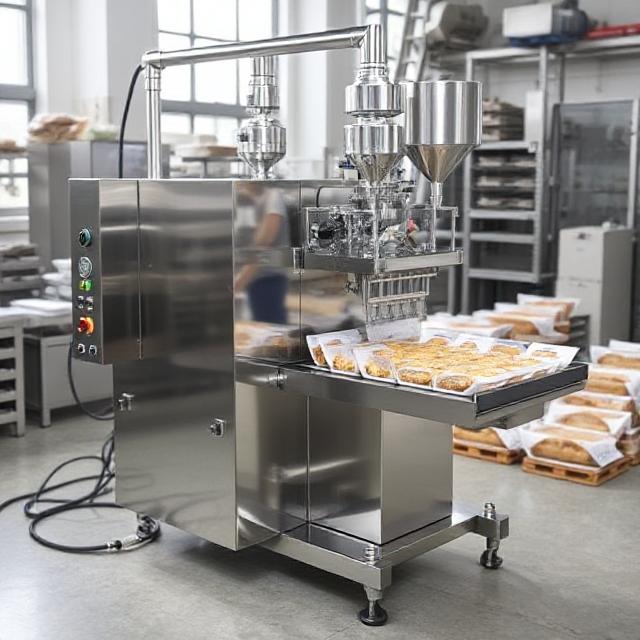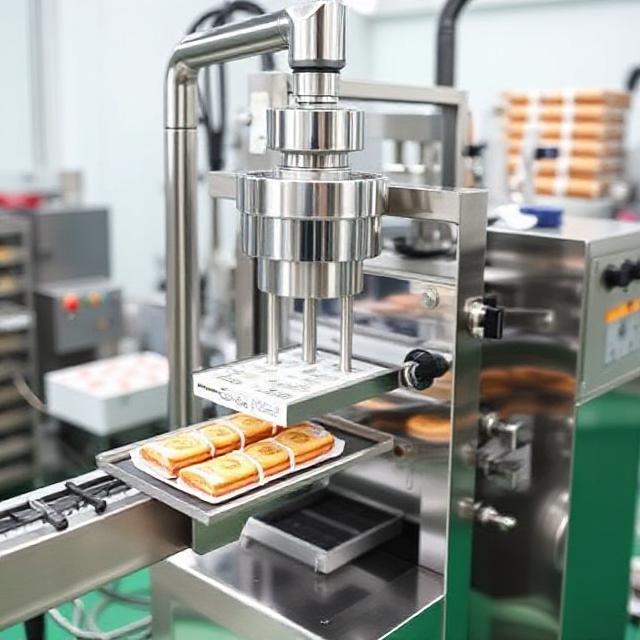Please Choose Your Language
T: +86-189-2891-8174
E: wechupack@yeah.net
E: wechupack@yeah.net
104 The Second Building, No.43 Haichong Road, Shiqi Town,Panyu District, Guangzhou City, China



Views: 0 Author: Site Editor Publish Time: 2025-06-10 Origin: Site








Packaging matters in the cookie industry. It keeps products fresh. It ensures shelf appeal. A cookie packaging machine takes this to the next level. It boosts speed. It improves accuracy. It protects quality.
Automation now leads cookie production. Manual packaging is too slow, inconsistent. Modern machines transform how bakeries operate. From small artisan shops to industrial cookie factories, automation shapes performance.
So, what does a cookie packaging machine do? It loads cookies. Wraps them. Seals them. Cuts the packs. Then passes them for boxing. Fast and precise, it handles thousands of cookies per hour.

A cookie packaging machine is a smart tool. It packs cookies quickly and neatly. It replaces manual labor. It boosts output.
How does it work?
Feeding cookies: Conveyor belts bring cookies into the machine.
Managing packaging film: It unwinds plastic or foil rolls.
Sealing and cutting: Heat or ultrasonic systems close and divide packs.
Discharge: Finished packs move to boxing or further processing.
This process repeats all day, non-stop. Most machines come programmable. They let users adjust speed, temperature, and pack length.
Flow wrappers are popular. They pack fast. They suit many cookie types. Flat, round, or square – it doesn’t matter.
How do they work?
Film moves constantly.
Cookies enter the wrapper.
The machine wraps, seals, and cuts packs.
Benefits:
Continuous flow = higher speed
Folded ends = professional look
Fits multiple sizes
Ideal for factories. They often run 400-800 packs per minute.

These use form-fill-seal technology. They make pillow-shaped bags. Good for singles or small batches.
Advantages:
Uses less packaging material
Seals 3 sides at once
Suits various cookie sizes
It cuts material waste. It runs faster than older systems. Flexible settings mean quick changeovers.
These machines add cookies to boxes. They stack wrapped cookies. Then insert them into cartons.
Perfect for:
Family packs
Bulk shipments
Retail boxes
The result is neat, shelf-ready packs. Cartoning machines often follow flow wrappers on full lines.
These systems do it all:
Feed cookies
Wrap or bag them
Load them into cartons
Seal cases
High automation. Low labor. Massive productivity.
Custom setups match any production need. Great for scaling cookie factories.

Why invest in one? Because a cookie packaging machine delivers value. Here are key benefits:
1. Faster efficiency
Machines outperform humans. They pack hundreds of cookies per minute.
2. Better freshness and seal quality
Air-tight packs keep cookies crisp. Consistent sealing reduces spoilage.
3. Lower labor cost
Fewer hands needed. That means long-term savings.
4. Flexibility
One machine handles multiple cookie types. Adjust settings, switch packaging formats.
5. Less waste
Precise cutting, sealing. Fewer errors. Lower material consumption.
Feeding matters. The wrong feed can damage cookies. Choose the right type:
| Feeder Type | Best For |
|---|---|
| Conveyor belts | Flat, uniform cookies |
| Vibratory feeders | Fragile or irregular cookies |
| Rotary disc feeders | Consistent high-speed loading |
Match cookie type to feeder. It avoids jams. Keeps cookies intact.
Packaging film rolls feed into machines. The machine:
Unwinds the film
Positions it over/around the cookie
Seals it tightly
Cuts it cleanly
Materials used:
Plastic film (visibility + barrier)
Metal foil (heat and moisture barrier)
Laminated film (strength + printability)
Sealing determines freshness. There are three types:
| Sealing Method | Use Case |
|---|---|
| Heat sealing | Plastic and laminate film |
| Ultrasonic sealing | Fragile cookies or heat-sensitive wraps |
| Mechanical crimping | Foil or non-heat sealable material |
Choose based on material and cookie fragility.
Modern machines use smart tech. Operators use touchscreens. Settings include:
Sealing temp
Pack size
Conveyor speed
Built-in sensors and PLCs control accuracy. It ensures uniform packs.
Safety matters. Machines include:
Emergency stop buttons
Interlock doors
Guard shields
They meet food industry safety codes. Fewer accidents. More peace of mind.
1. Production speed
Estimate how many packs/hour you need.
2. Cookie size and shape
Flat, filled, sandwich? Make sure your machine can handle them.
3. Packaging material
Your wrap must match the machine's sealing tech.
4. Budget
Include not just purchase price but long-term operating cost.
5. Ease of use
User-friendly interfaces cut training time.
6. Maintenance
Go for machines with easy cleaning and low maintenance needs.
7. Compatibility
New machine must integrate with your production line.
Cookies hate moisture. Good seals and barriers help:
Plastic film: blocks water
Foil: locks out oxygen
Heat seal: closes tightly
This combo extends shelf life.
Pretty packaging sells. Machines use:
V-shaped guides
Molds
Dividers
These keep cookies aligned. Neat rows = better shelf appeal.
Your pack should fight:
Moisture
Light
Air
Breakage
Use double-layered packs. Inner plastic + outer carton. It adds strength and protection.
Packaging is your brand's first impression. Add:
Custom prints
Clear windows
Logos
QR codes
Zip locks
Tell a story. Make it easy to read. Make it pop on shelves.
Keep your cookie packaging machine healthy. Here’s how:
Cleaning
Wipe down machines daily. Remove crumbs and dust.
Lubrication
Oil moving parts weekly.
Check parts
Replace worn belts, blades, and seals regularly.
Calibration
Set correct seal temps. Adjust film feed speeds.
Common issues
Poor seals: Check heat and pressure.
Jams: Inspect feeder alignment.
Misfeeds: Check sensor timing.
Well-maintained machines run better and last longer.
Protect your team. Follow these steps:
1. Train staff
Give full training. Ensure they understand machine features.
2. Use PPE
Wear gloves, goggles, aprons.
3. Guard machines
Cover moving parts. Lock doors when in use.
4. Emergency protocol
Teach where the E-stop is. Practice emergency drills.
5. Maintenance lockout
Use lockout/tagout during servicing.
Safe operations = zero accidents.
They use manual or semi-automatic machines. Key focus: branding. Smaller machines allow custom pack styles.
Examples:
Hand-fed sealers
Tabletop pillow pack units
They scale with flexibility. Use flow wrappers or cartoners.
Needs:
Easy pack size changes
Fast label switching
They use full lines. Speed and volume are everything.
Setup includes:
Robotic feeders
Auto sorters
Cartoning + case sealing
These lines handle 1,000+ packs/min.
Q1: What speed should I expect from a cookie packaging machine?
Speeds range from 100 to 1,000+ packs/min. Depends on type and complexity.
Q2: Can one machine handle different cookie shapes/sizes?
Yes. Most modern machines have adjustable molds and settings.
Q3: How do I ensure freshness?
Use high-barrier materials and tight seals. Vacuum and nitrogen flush add protection.
Q4: Are machines customizable?
Absolutely. Choose optional parts: date printers, zipper sealers, multi-pack sorters.
Q5: What is the machine lifespan?
5–10 years with good maintenance.
A cookie packaging machine drives speed, efficiency, and product quality. It cuts costs. It boosts output.
Match machine type to your scale. Consider cookie size, pack style, and volume.
Checklist before buying:
Confirm production goals
Test different materials
Ask for sample runs
Check local support availability
Compare models. Read user reviews. Get supplier demos.
Table: Machine Types vs. Bakery Size
| Bakery Type | Recommended Machine | Output Estimate |
|---|---|---|
| Home/startup | Manual sealer or tabletop flow wrap | 10–50 packs/hr |
| Small bakery | Semi-auto pillow pack | 100–200 packs/hr |
| Mid-size facility | Flow wrapper + cartoner combo | 500–800 packs/hr |
| Large manufacturer | Fully automated line + robot loader | 1,000+ packs/hr |
A smart investment in packaging pays off. Choose the best cookie packaging machine for your business. Keep cookies fresh. Boost your brand. Win customer loyalty.
Start now. Evaluate needs. Explore suppliers. Make packaging your competitive edge.
The Ultimate Guide To Filling Machines for Cosmetics
The Ultimate Guide To Pouch Packing Machines:Types,Benefits,And Buying Tips
Types of Sealing Machines: 13 types of Packaging Solutions Sealing Machines
The Ultimate Guide To Choosing The Right Coffee Packaging Machine